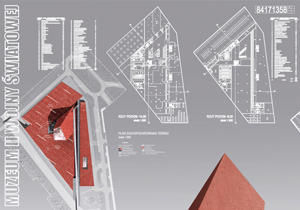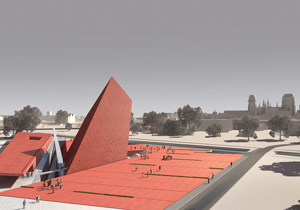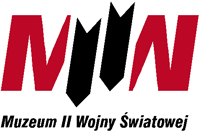 |
 |
 |
 |
 |
 |
| |
 |
|
 |
 |
 |
  |
  |
 |
 |
 |
 |
| MUSEUM OF THE SECOND WORLD WAR IN GDANSK, POLAND
|
|
September 2, 2010
 The winner of the architectural competition for the building of the Museum of the Second World War in Gdańsk, Poland, is the Studio "Kwadrat", Gdynia, Poland. The winner of the architectural competition for the building of the Museum of the Second World War in Gdańsk, Poland, is the Studio "Kwadrat", Gdynia, Poland.
The purpose of the competition is to select the architectural concept of the building to house the Museum of the Second World War, together with the concept of landscape development. 240 firms from 33 countries of the world participated in the contest.
The verdict of the Jury, in which Daniel Libeskind was one of the members, says: "In its Design, the innovative, huge-scale project makes use of the unique air of the city and transforms it in a modern manner. The colour and texture proposed in the design smoothly blend with the colours of Gdańsk giving the museum the power to pass the test of the 21st century."
The construction works on the Museum will commence in 2012. A ceremonious opening of the new building is planned for 1 September 2014 – on the 75th anniversary of the outbreak of World War II.
 Images gallery Images gallery
Drawings gallery
Members of the jury:
Wiesław Bielawski - chairman, Grzegorz Buczek – juror scrutinizer, Wiesław Czabański – juror scrutinizer, Wojciech Duda, George Ferguson, Wiesław Gruszkowski, Daniel Libeskind, Jack Lohman, Andrzej Pągowski, Hans Stimmann held the session.
The Jury’s verdict:
Prize I EUR 80,000- entry no. 117 - 92 pt – Studio Architektoniczne „Kwadrat”, Gdynia; Poland.
Prize II EUR 50,000- entry no. 125 - 79 pt – Piotr Płaskowicki & partnerzy Architekci; Warszawa; Poland.
Prize III EUR 30,000- entry no. 21 - 75 pt – BETAPLAN S.A. ; Ateny; Greece.
Pecuniary distinctions:
Distinction I EUR 10,000- entry no. 11 - 70 pt - Ad Artis Emerla Jagiełłowicz Wojda Spółka Jawna; Kraków; Poland.
Distinction II EUR 10,000- entry no. 31 - 68 pt - „DIZARH” Ltd.; Varna, Bulgaria.
Distinction III EUR 10,000- entry no. 36 - 65 pt - Selim Velioglu; Bagdad; Turkey.
Distinction IV EUR 10,000- entry no. 124 - 64 pt - „Domino” Grupa Architektoniczna Wojciech Dunaj – Szczecin, Poland.
The Jury has also decided to award 8 honorary mentions to the entries with the following numbers:
- no. 1 - Max Rieder Ziviltechniker GMBH & Architekt Wagner ZT GMBH; Austria.
- no. 26 - Perumal Pedavoli PTY LTD; Australia.
- no. 32 - Kimmel Eshkolot Architects Ltd.; Israel.
- no. 49 - Hago-Architekci, Gdynia; Poland.
- no. 50 - PPW Fort, sp. zo.o.; Gdańsk, Poland.
- no. 51 - Partnerstwo Art. Rays; Bulgaria.
- no. 76 - Spółka Projetesanas bijos ARCHIS; Latvia.
- no. 78 - JKMM Architects; Finland.
Justification of the Jury’s opinion on the awarded entries:
Prize I: Justification of the Jury on the entry no. 117
 The Jury is of the opinion that the design selected in the Architectural Competition has every chance of becoming one of the most important features of the Gdańsk City Centre from the very beginning. In our belief it meets all conditions of joining in the sophisticated symbols in the future alongside the Armoury, St Mary’s Church, or the Crane. The Jury is of the opinion that the design selected in the Architectural Competition has every chance of becoming one of the most important features of the Gdańsk City Centre from the very beginning. In our belief it meets all conditions of joining in the sophisticated symbols in the future alongside the Armoury, St Mary’s Church, or the Crane.
The huge building tactfully merges in the neighbourhood sharing the chance of becoming an icon of Gdańsk with the major historic elements around. The minimalist means of architectural expression proposed by the authors gracefully blend the modern idea of the building with the historic background. In its Design, the innovative, huge-scale project makes use of the unique air of the city and transforms it in a modern manner. The colour and texture proposed in the design smoothly blend with the colours of Gdańsk giving the museum the power to pass the test of the 21st century.
 The design embraces an immense building, which serves varied purposes. Dynamic, huge in scale, the building carries an air of a sculpture created by the visitors. It rises symbolically from the ground, led by light, bold, Simple, and naked, symbolically placed in the geometry of the shipyard. It links the ground – its gloom, chill, and imprint of the Past, with the skies – hope, freshness, and Future. In this ingenious design, a rational vision of a public facility meets the wealth of history. It rings full sound, telling a story hard to chew for any generation, the story we must never forget. The attractive body of the building cumulates emotions, portrays the terror of war without depriving us of hope. It does not leave its interpreters buried in the gloom of the difficult topic. The design embraces an immense building, which serves varied purposes. Dynamic, huge in scale, the building carries an air of a sculpture created by the visitors. It rises symbolically from the ground, led by light, bold, Simple, and naked, symbolically placed in the geometry of the shipyard. It links the ground – its gloom, chill, and imprint of the Past, with the skies – hope, freshness, and Future. In this ingenious design, a rational vision of a public facility meets the wealth of history. It rings full sound, telling a story hard to chew for any generation, the story we must never forget. The attractive body of the building cumulates emotions, portrays the terror of war without depriving us of hope. It does not leave its interpreters buried in the gloom of the difficult topic.
The elegant pavilion, together with the obelisk nearby, squeezes into the ground and strikes the viewer with light, creating a symbol of catastrophe and the surviving hope. Phoenix-like, the building rises from Mother Earth, its ashes, towards the sky. The building will easily imprint itself on the visitors minds, conveying and being an unforgettable experience, both due to its interior and exterior. It will become a major feature on the plan of Gdańsk, perfectly composed in space.
The well-organised and modern building combines an immense range of functions . It offers huge space for permanent exhibitions, while remaining open for any displays in the future. The visitors to and the residents of the Tri-City will love it as an attraction. The designed tower will play a major role in gaining an image of the entire city, offering a fresh perspective view of Gdańsk, which will enhance the Museum’s valuable function of a viewing point.
As a public space, the Museum Has the potential of a meeting place for families, tourists, and acquaintances, of taking in dozens of cars. It incorporates an ingenious concept with functionality.
This exceptionally designed Museum of the Second World War will become a major attraction, telling the story of paramount importance for the humanity. It will grow to become a timeless symbol inscribed in the hearts of the people of Gdańsk, Poland, and Europe.
Prize II: Justification of the Jury on the entry no. 125
In this entry, the thoughtful historic narration representing ‘cities and war, the present and the future’ has been successfully conveyed in a symbolic, and yet functional form. The intriguing architectural proposal welcomes its visitors, with its clear rationale and message, representing a strong but somehow literal link between the old and developing Gdańsk of the 21st century. This entry has a very clear and well organized strategy, based on a story about destruction and revival. These are represented by two very distinct elements, separated by the route through the site, which respects the pre-war plan and in particular the diagonal axis of Grosse Gasse.
The philosophy behind the plan and design is based on the post-modern representation of the destruction and suffering of European cities and in particular of Gdańsk because of its significant position both at the start and end of the war.
Prize III: Justification of the Jury on the entry no. 21
The Jury agreed that the proposed solution is both attractive and sophisticated, and welcomed its overall tone. It was felt that the proposed buildings smartly bring together the experience of war with allusions to the present and the future as expressed by the series of exhibition containers and the multi-functional building that provides a binding back up to the complex. The play of dark and light spaces was considered positive. The Jury welcomed the allusion to the former street scape and felt the Museum would work well in the context of the City without dominating it. The notion of recreating the site’s historic memory has a specific resonance here and the opening of specific vistas was praised. But the Jurors felt this was not sufficient enough to represent the programme of the Second World War Museum and its importance.
Facts
 The Museum of the Second World War was formed on 26 November 2008 by virtue of the Ordinance of the Minister of Culture and National Heritage, Bogdan Zdrojewski. Gdańsk, the city where the war broke out, was selected to be the seat of the institution. The Museum of the Second World War was formed on 26 November 2008 by virtue of the Ordinance of the Minister of Culture and National Heritage, Bogdan Zdrojewski. Gdańsk, the city where the war broke out, was selected to be the seat of the institution.
On 1 September 2008, Chairman of the Council of Ministers, Donald Tusk, appointed prof. dr hab. Paweł Machcewicz his Plenipotentiary for the Second World War Museum and entrusted him with the task of preparing the conceptual idea of the Museum. A year later, on Westerplatte, during the celebrations of the 70. anniversary of the outbreak of World War II, the Prime Minister signed the museum’s Deed of Foundation Laying and officially opened the open-air exposition entitled ‘Westerplatte: A Resort – Bastion – Symbol.’
It is the mission of the Second World War Museum to create a modern outlet to tell the history of the war, the greatest cataclysm of the 20th century. This mission statement is perfectly valid considering that even though more than 70 years have passed since the outbreak of World War II there is no museum in Europe that would present a comprehensive view of the conflict, its development and nature.
The list of the museum’s top goals includes familiarising the world with the picture of the war, as experienced in Poland and other countries of Central and Eastern Europe. The experience is largely different and at the same time barely known to Western Europe or the world beyond. The historic facts will highlight the stories and fate of individual human beings, communities, and nations. The military events will be reduced to the background of the narration portraying everyday life of the civilians and soldiers, the terror of occupation, such phenomena as genocide, the resistance staged against the occupant, and the high level politics. The purpose of the approach is to visualise the unmet nature of the Second World War, which took the highest toll of the civilian population.
On 9 December 2009, a notarial deed concerning the building plot designated for the erection of the Museum of the Secord World War was ceremoniously signed at the Polish Post Museum in Gdańsk. The City authorities donated 1.7 ha of land worth over PLN 53 million to the Museum free of charge. Wałowa Street runs across a picturesque, even though slightly forgotten pocket of the Old Town of Gdańsk, neighbouring on the Radunia Canal embankment and in the immediate vicinity of the historic building of the Polish Post of the Free City of Gdańsk.
|
|
 |
  |
 |
|
|